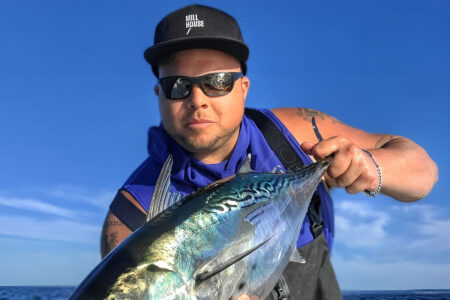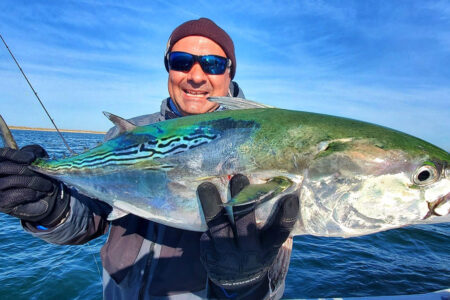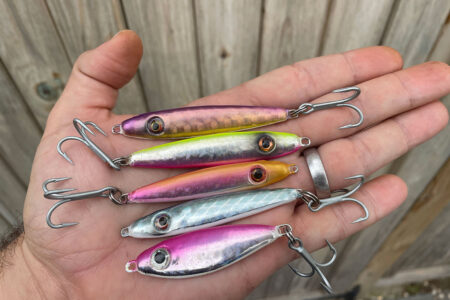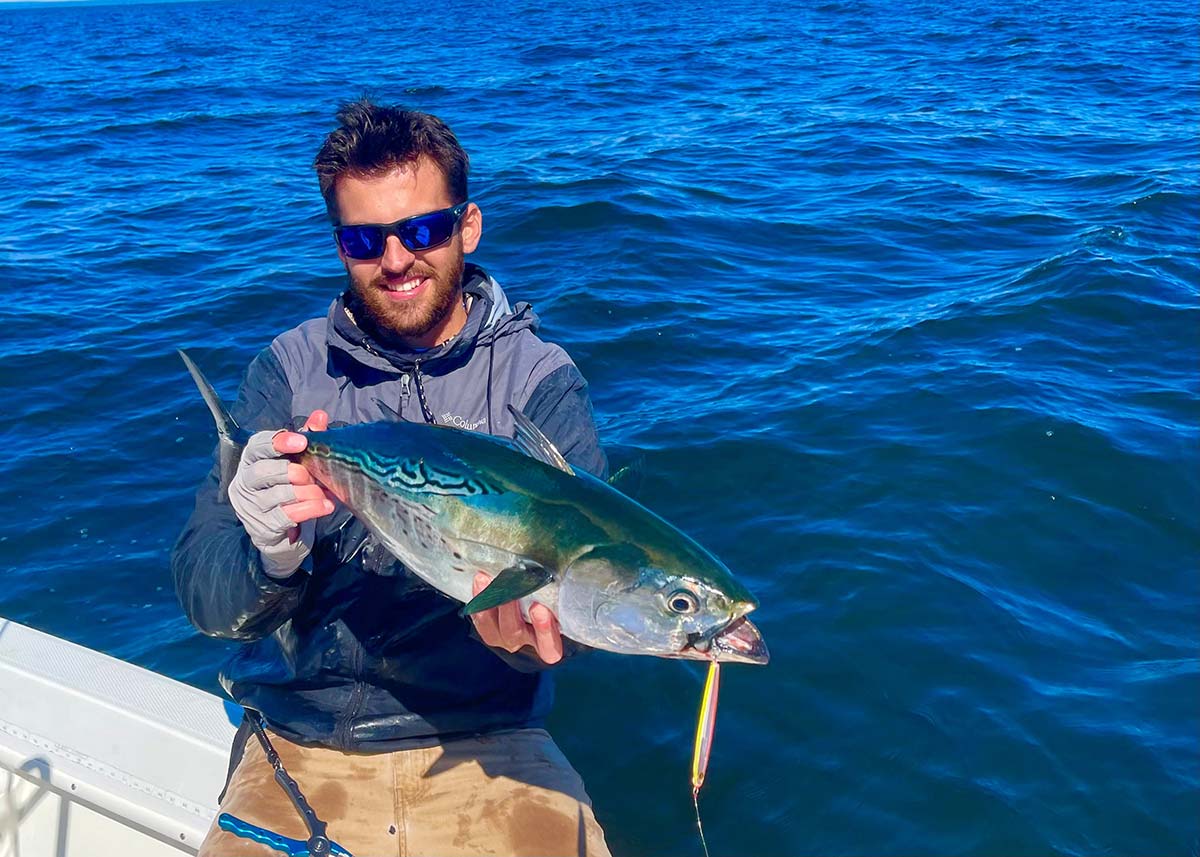
Long Island Sound has become a premier spot to hunt for false albacore!
False albacore, albies, fat Alberts, green machines…whatever you want to call them, these little torpedoes consume the lives of not only myself, but thousands of anglers throughout the Northeast, beginning every August and lasting well into November! Just like the rest of you, I anxiously await their arrival each year here in Long Island Sound. And I know I am not the only one.
It could be argued that these pelagic, open water fish have become, the most sought after gamefish during the fall run. They spend most of their lives in the open water, wandering the endless oceans, while reproducing, eating just about everything in sight and growing at a rapid pace. And then, in the fall, the shorter days and cooling backwaters send forth the plethora of baitfish that have been growing there all summer, it’s basically a ticking time bomb of bait—and the albies come rushing inshore to take advantage.
These fish arrive like clockwork, and I personally believe false albacore, along with just about every other “migrating” animal on earth, uses the angle of the sun as a calendar or indicator, that tells them when to migrate. And once the sun hits that perfect angle in the sky, the false albacore begin to head inshore for that all-you-can-eat backwater buffet. That is why, most years, the very first reports of false albacore making their way closer to shore, come from commercial and recreational tuna fishermen, making their way to and from the tuna grounds.

In The Sound
I do most of my albie fishing in the western half of Long Island Sound, basically from Stratford Shoals west. I rely on reports of albies entering the Race or populating the waters around Fishers Island, Montauk or Plum Gut to tell me when to begin looking for them. Once they arrive in those places, usually between September 10 and 20, I look to the next moon or the next hard east wind to get them moving deeper into the Sound. Because there is so little structure between these areas and Stratford Shoals (also known as Middle Ground), the albies tend to traverse those 40 miles of open Sound rather quickly and Middle Ground is usually among the first places we find them in my neck of the woods. Every single year, this general area is where I see them, locally, first.
I will usually, find them foaming, or “ram induction” feeding on bay anchovies in deep, open water and in very big schools. After a little while they will begin to then spread out, further west and sometimes even into very shallow water, near points, islands, and reefs. This usually happens as we get into the month of October. This is when you have your best shot at a ‘shore core’ in Connecticut.
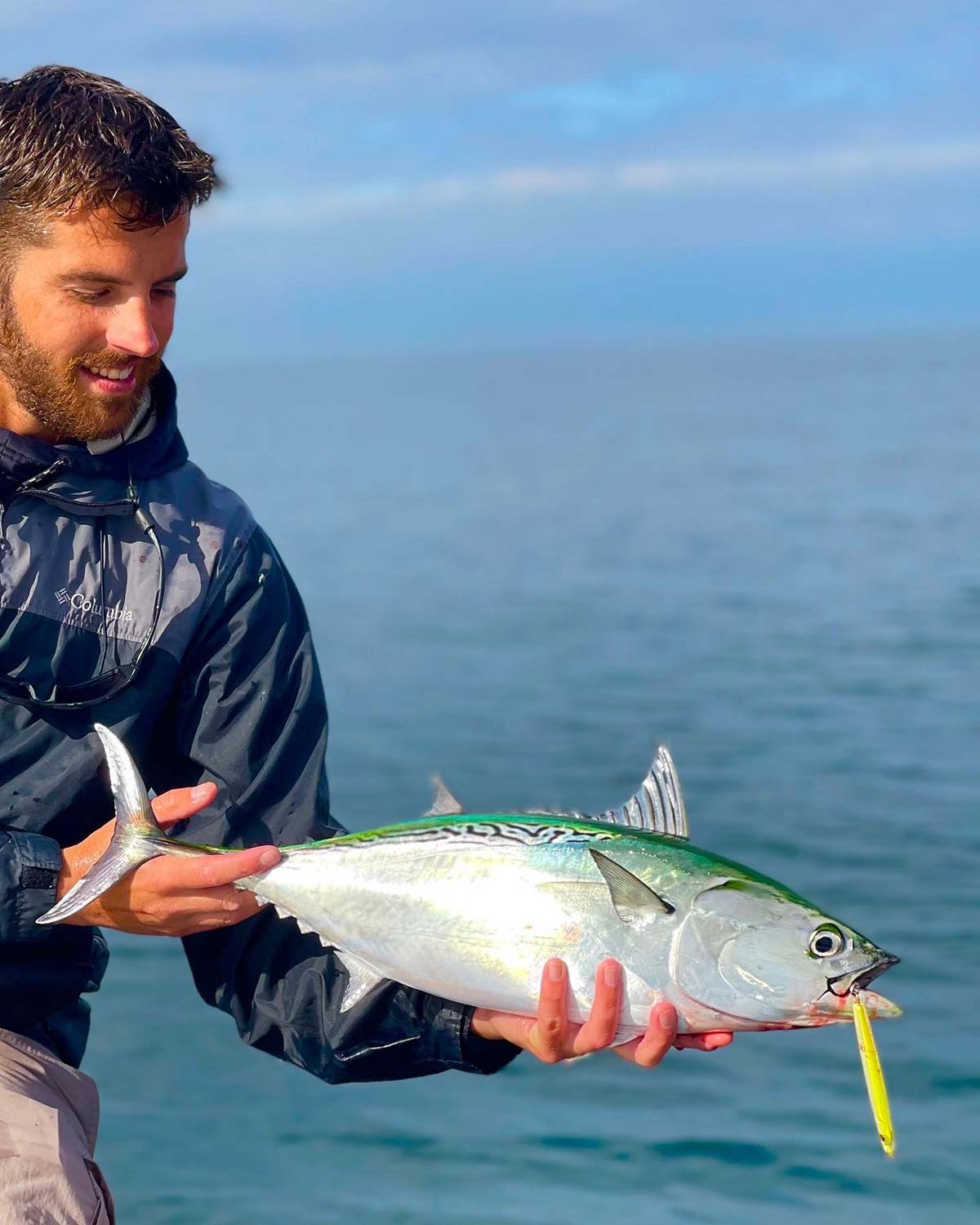
A Protected Fishery
One of the unique things about albies and Long Island sound, compared to other nearby bodies of water, is once they filter into the sound, they almost get “landlocked” and seem to become sidetracked by all of the food which usually keeps them around for a while, some seasons we’ve had them for the better part of two months! The fishing stays very consistent, as well, assuming no huge storms cut the season short. They can’t retreat offshore, once deep into Long Island Sound and storms and hurricanes that scrape by our coast during the fall, do not impact our fishing as much, as say, Rhode Island or Montauk. Another unique aspect to chasing albies in Long Island Sound, is the crowds. There aren’t any! Also, they can set up on both sides of the sound (CT and NY) keeping anglers spread out and happy. This is one of the main reasons, Long Island Sound, that’s right, Long Island Sound is my favorite place to chase and fish for these speed demons.
It is also important to remember, high salinity and food are two of the most important factors to having a “good” local albie season here. There is so much fresh water runoff into Long Island Sound, from all of the rivers as it is, so obviously, the perfect set up for us would be if there was very little rain all summer, a lot of food around, cool nights and sunny warm/mild days. Two recent standout years were 2015 and 2017, when I think of these conditions and it’s a bit ironic that those turned out to be “epic” false albacore seasons for Long Island Sound. Some rain is fine, as long as, most of it flushes out by September. Another factor to keep in mind, is the weather to our north. Most of our river systems start in central and northern New England, so even if we don’t get a lot of rain locally, but Vermont and New Hampshire do, Long Island Sound will suffer the consequences. But, despite all of these factors that come into play every year, and seem to go against us, luckily, the albies almost always show in numbers every season. Sometimes a little extra burnt fuel and effort is all that is needed to chase down these fish during the tougher years.
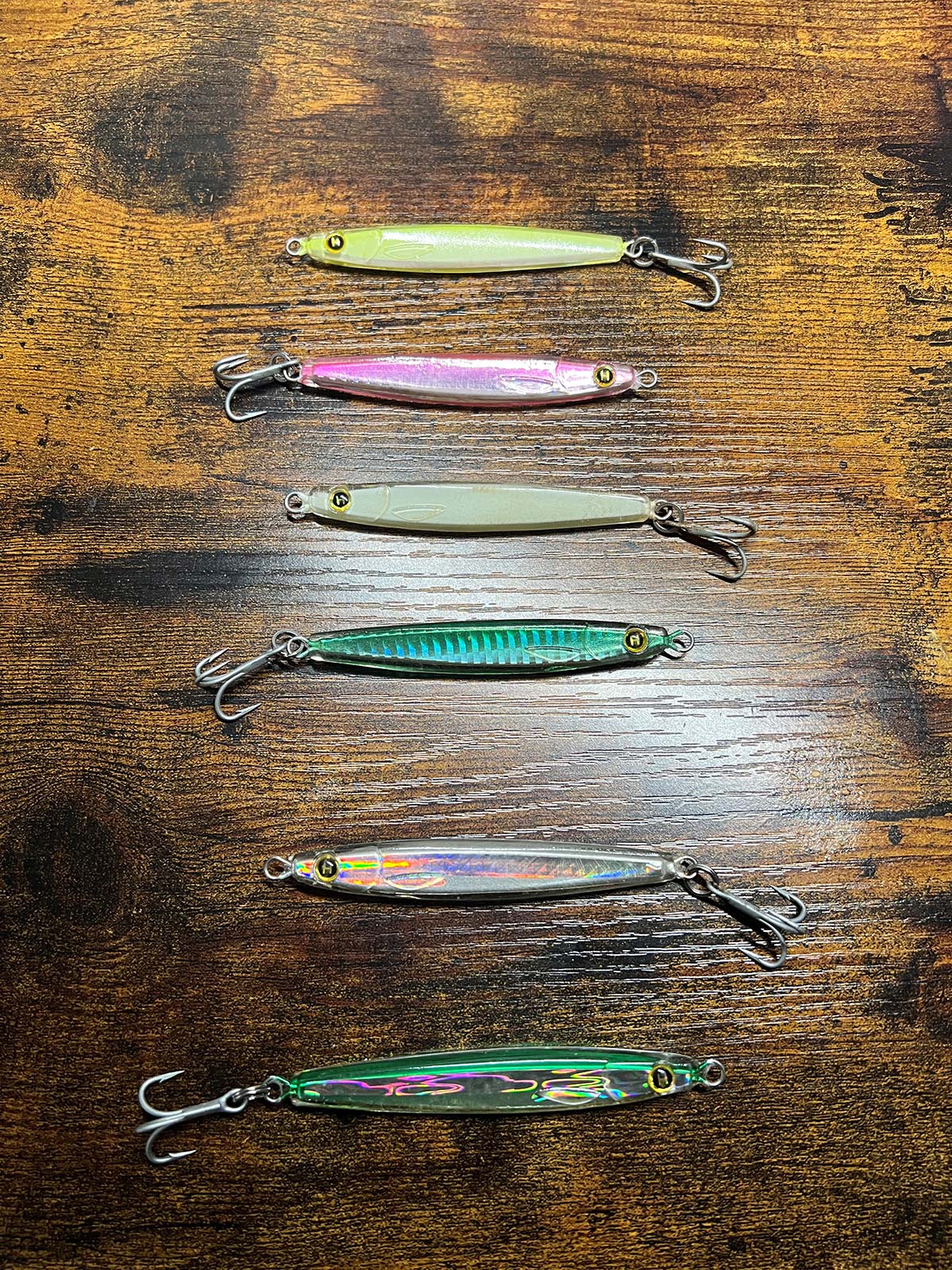
Pro Tips:
Casting and Accuracy
Albies can be frustrating little buggers. They usually feed in formation, fast, ferociously, and in harmony with one another. It is for this very reason, I believe an accurate cast is WAY more important than the color or size of your Epoxy Jig. Oftentimes, when albies are being very difficult, I see anglers constantly changing lures, and spending more time tying, clipping and unclipping. Next time you find yourself in this situation, take a deep breath and work on making better, and more accurate casts.
I only fish 7/8-ounce Epoxy Jigs, usually in silver, glow or white: nice and simple. I stick with that size whether they are on half-inch bay anchovies, bait I can hardly even see, 2-inch silversides and or 3- to 4-inch peanuts. Trust me, it doesn’t matter. Make a better cast, and you will catch more albies. Instead of constantly changing lures with my clients, I will spend extra time with them working on their casts while also trying my best at putting them in a position, with the boat, to make an accurate and effective cast. Some guys like to go lighter on the epoxy jigs, when they are on small bait or picky, but in reality all this is doing is effecting the distance of your cast, in a negative way. Observe the fish and the direction they (and the baitfish) are moving, make your jig swim in the same direction and place your cast where the fish will be when the lure lands, not where you last saw them.
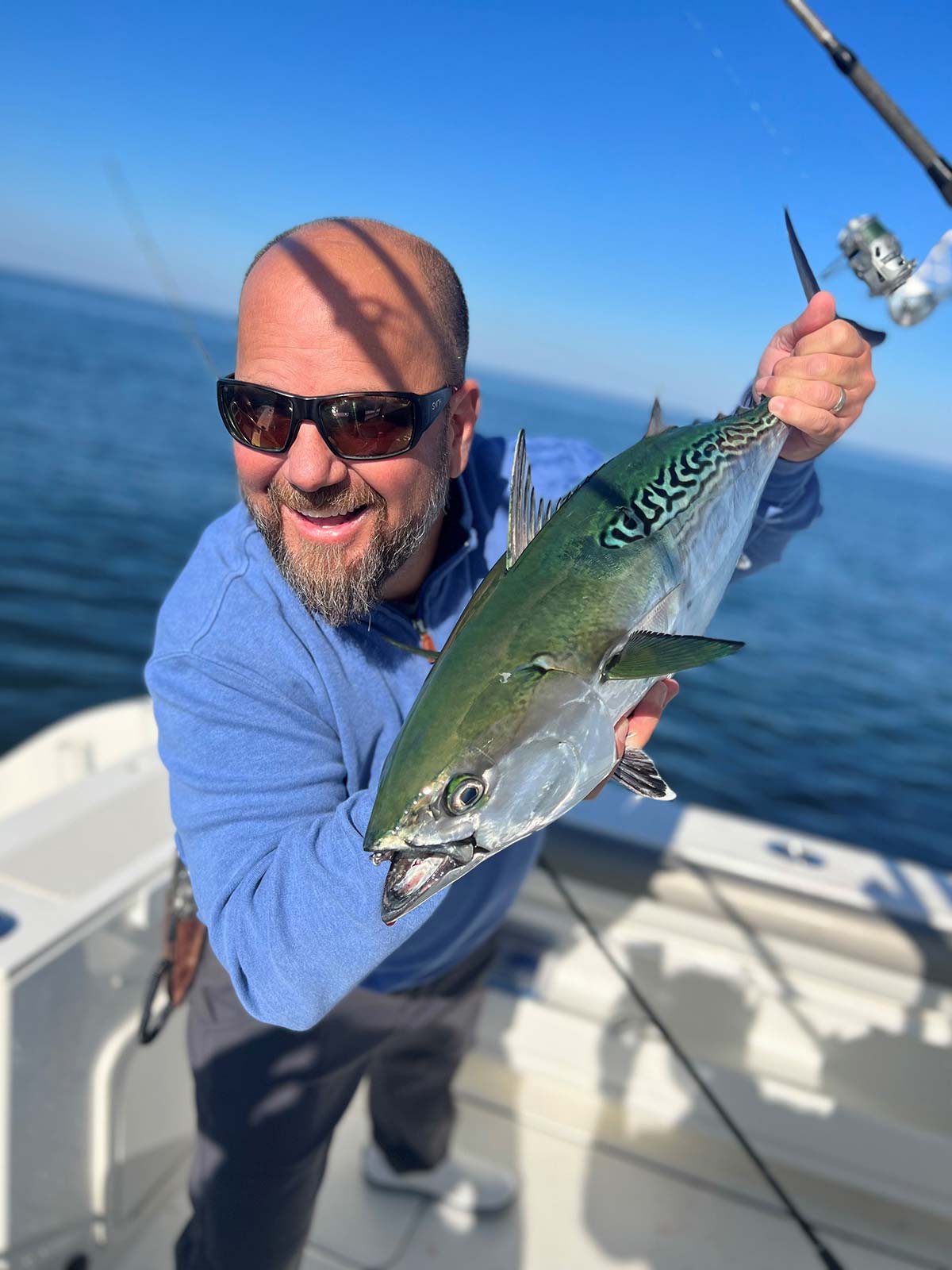
Walk and Gun
This is a tactic we use offshore when looking for tuna on the surface and it works just as well inshore when targeting false albacore and/or bonito. I will keep the boat in gear and moving, and work a general area I think is holding fish, very hard, until they rise up to the surface to feed, again. When this happens, it doesn’t last for very long, so it is important to already be in gear and moving towards the feeding frenzy, when it does happen. Kind of like getting a head start.
| SHORE CORE? |
| I have, personally caught over a dozen false albacore from shore in Fairfield County, so I don’t want to hear that it cannot be done or that it hasn’t been done. I also know several local sharpies and guides that have also done it. But I will admit that landing a tunoid from shore is a tall task, especially in Connecticut. My most success from the shoreline, around Fairfield County has been where points and or reefs extend out into Long Island Sound the furthest. Penfield Reef, in Fairfield, Connecticut immediately comes to mind, because during a falling tide, and or at dead low tide you can essentially walk over a mile out into the sound. Working both the east and west sides of the reef. Be ready to run, a lot. This specific spot can also be very dangerous, if you aren’t familiar with the area or the tides, but it definitely gives you your best shot at a shore core in Fairfield County Connecticut. It’s best to walk the reef on a falling tide and to work your way back in with the tide, never letting the water get over your knees. The furthest west into Long Island Sound false albacore usually swim is the Norwalk Islands, and across to Northport on Long Island. |
I have been chasing these fish since the early 2000s and I have realized over the years, it is far better to walk and gun, move slowly and try to pattern them, rather than repeatedly running them over, and spooking them. Their feeds are quick and ferocious, sometimes too quick to even chase, because by the time you get to them, they will most likely sound. This is why it is better to pattern them and work the areas where they have been feeding on the surface, because when they do come back up to feed, instead of seeing it in the distance and having to chase the school, the fish will already be nearby and you will already be in a much better position to execute the best cast possible. This goes for both fly and spin.
Watching this fishery evolve in Long Island Sound over the years has really been a sight to behold. It seems like every year it gets better and better. Maybe that’s because I’ve become more dialed in, but before the 1990’s these fish weren’t even known to come into Long Island Sound, now we have some of the best albie runs on the East Coast, all in 30 years! What will it be like in another 30 years? Only time spent on the water, will tell.

